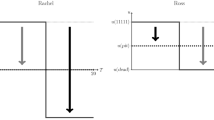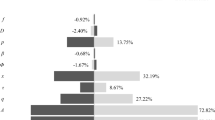Abstract
The value of reducing health and mortality risks is often measured using value per statistical life (VSL) or one of several life-year measures (e.g., life years, quality-adjusted life years, disability-adjusted life years). I derive the utility function that is admissible when preferences for health and longevity, conditional on wealth, are consistent with any life-year measure (LYM) and examine the implications for marginal willingness to pay (WTP) for increases in health, longevity, and current-period survival probability. I conclude that marginal WTP for any LYM is decreasing and that VSL is increasing in the LYM. These results imply that cost-effectiveness analysis using a fixed monetary value per LYM is not consistent with economic welfare theory and that the benefit of a health improvement cannot be calculated by multiplying the change in a LYM by a constant.
Similar content being viewed by others
Notes
Constant exponential discounting is most common, but other discounting functions can be incorporated by replacing δ τ with δ τ (Harvey 1994).
Murphy and Topel (2006) define V(·) as a function of both consumption and leisure.
For values of w sufficiently small, it is possible that utility is decreasing in t. Assumption (1.10a) may be interpreted as excluding values of w for which life is worse than death.
That is, V(x) = x (1–r)/(1 – r), r ≠ 1; V(x) = ln(x), r = 1, where r is the measure of relative risk aversion (Pratt 1964).
That is, V(x) = (1/r) (1 – e -rx) where r is the discount rate and also the Arrow-Pratt measure of absolute risk aversion (Pratt 1964).
Using model (1.2) to estimate WTP per QALY, Bleichrodt and Quiggin (1999) assume that individuals allocate medical and other spending to obtain constant health and consumption over their lifetimes. The assumption that health can be made constant over the lifecycle through allocation of spending seems implausible given that health deteriorates with age and not all impairments can be eliminated by treatment.
One reason that VSL increases with age over younger ages is that income rises over these ages and individuals cannot borrow against future increases. Hence VSL and current consumption are correlated over the lifecycle (Kniesner et al. 2006). In contrast, equation (5.2) is conditioned on fixed wealth.
The effect of financial risk aversion on VSL is also ambiguous (Eeckhoudt and Hammitt 2004).
References
Adler, M. (2006). QALYs and policy evaluation: A new perspective. Yale Journal of Health Policy, Law, and Ethics, 6, 1–92.
Aldy, J. E., & Viscusi, W. K. (2007). Age differences in the value of statistical life: Revealed preference evidence. Review of Environmental Economics and Policy, 1, 241–260.
Aldy, J. E., & Viscusi, W. K. (2008). Adjusting the value of a statistical life for age and cohort effects. Review of Economics and Statistics, 90, 573–581.
Aumann, R. J., & Kurz, M. (1977). Power and taxes. Econometrica, 45, 1137–1161.
Barksy, R. B., Juster, F. T., Kimball, M. S., & Shapiro, M. D. (1997). Preference parameters and behavioral heterogeneity: An experimental approach in the Health and Retirement Study. Quarterly Journal of Economics, 112, 537–580.
Bleichrodt, H., & Quiggin, J. (1999). Life-cycle preferences over consumption and health: When is cost-effectiveness analysis equivalent to cost-benefit analysis? Journal of Health Economics, 18, 681–708.
Bleichrodt, H., Wakker, P., & Johannesson, M. (1997). Characterizing QALYs by risk neutrality. Journal of Risk and Uncertainty, 15, 107–114.
Bommier, A., & Villeneuve, B. (2012). Risk aversion and the value of risk to life. Journal of Risk and Insurance, 79, 77–103.
Cutler, D.M., & Richardson, E. (1997). Measuring the health of the U.S. population. Brookings Papers Microeconomics, 217–271.
Dolan, P., & Edlin, R. (2002). Is it really possible to build a bridge between cost-benefit analysis and cost-effectiveness analysis? Journal of Health Economics, 21, 827–843.
Domeij, D., & Johannesson, M. (2006). Consumption and health. Contributions to Macroeconomics 6(1), Article 6.
Drèze, J. (1962). L’utilité sociale d’une vie humaine. Revue Française de Recherche Opèrationelle, 6, 93–118.
Eeckhoudt, L. R., & Hammitt, J. K. (2004). Does risk aversion increase the value of mortality risk? Journal of Environmental Economics and Management, 47, 13–29.
Eeckhoudt, L. R., Godfroid, P. H., & Marchand, M. (1998). Risque de santé, médicine préventive, et médicine curative. Revue d’Économie Politique, 108, 321–337.
Evans, W. N., & Viscusi, W. K. (1991). Estimation of state-dependent utility functions using survey data. Review of Economics and Statistics, 73, 94–104.
Finkelstein, A., Luttmer, E. F. P., & Notowidigdo, M. J. (2013). What good is wealth without health? The effect of health on the marginal utility of consumption. Journal of the European Economic Association, 11(S1), 221–258.
Foncel, J., & Treich, N. (2005). Fear of ruin. Journal of Risk and Uncertainty, 31, 289–300.
French, M. T., & Mauskopf, J. A. (1992). A quality-of-life method for estimating the value of avoided morbidity. American Journal of Public Health, 82, 1533–1555.
Garber, A. M., & Phelps, C. E. (1997). Economic foundations of cost-effectiveness analysis. Journal of Health Economics, 16, 1–31.
Gold, M. R., Siegel, J. E., Russell, L. B., & Weinstein, M. C. (1996). Cost-effectiveness in health and medicine. Oxford: Oxford University Press.
Grossman, M. (1972). On the concept of health capital and the demand for health. Journal of Political Economy, 80, 223–255.
Hammitt, J. K. (2002). QALYs versus WTP. Risk Analysis, 22, 985–1001.
Hammitt, J. K., Haninger, K., & Treich, N. (2009). Effects of health and longevity on financial risk tolerance. Geneva Risk and Insurance Review, 34, 117–139.
Haninger, K., & Hammitt, J. K. (2011). Diminishing willingness to pay per quality-adjusted life year: Valuing acute foodborne illness. Risk Analysis, 31, 1363–1380.
Harvey, C. M. (1994). The reasonableness of non-constant discounting. Journal of Public Economics, 53, 31–51.
Hirth, R. A., Chernew, M. E., Miller, E., Fendrick, A. M., & Weissert, W. G. (2000). Willingness to pay for a quality-adjusted life year: In search of a standard. Medical Decision Making, 20, 332–342.
Johannesson, M. (1995). The relationship between cost-effectiveness analysis and cost-benefit analysis. Social Science and Medicine, 41, 483–489.
Johnson, F. R., Fries, E. E., & Banzhaf, H. S. (1997). Valuing morbidity: An integration of the willingness-to-pay and health-status index literatures. Journal of Health Economics, 16, 641–665.
Jones-Lee, M. W. (1974). The value of changes in the probability of death or injury. Journal of Political Economy, 82, 835–849.
Keeney, R., & Raiffa, H. (1993). Decisions with multiple objectives: Preferences and value tradeoffs. Reprint, Cambridge: Cambridge University Press.
Kniesner, T., Viscusi, W. K., & Ziliak, J. (2006). Life-cycle consumption and the age-adjusted value of life. Contributions to Economic Analysis & Policy, 5(1), 1–34. Article 4.
Krupnick, A. (2007). Mortality-risk valuation and age: Stated-preference evidence. Review of Environmental Economics and Policy, 1, 261–282.
Krupnick, A., Alberini, A., Cropper, M., Simon, N., O’Brien, B., Goeree, R., & Heintzelman, M. (2002). Age, health, and the willingness to pay for mortality risk reductions: A contingent valuation survey of Ontario residents. Journal of Risk and Uncertainty, 24, 161–186.
Mehrez, A., & Gafni, A. (1989). Quality adjusted life years, utility theory, and healthy years equivalents. Medical Decision Making, 9, 142–149.
Meltzer, D. (1997). Accounting for future costs in medical cost-effectiveness analysis. Journal of Health Economics, 16, 33–64.
Miyamoto, J. M., & Eraker, S. A. (1985). Parameter estimates for a QALY utility model. Medical Decision Making, 5, 191–213.
Miyamoto, J. M., Wakker, P. P., Bleichrodt, H., & Peters, H. J. M. (1998). The zero-condition: A simplifying assumption in QALY measurement and multiattribute utility. Management Science, 44, 839–849.
Moore, M. J., & Viscusi, W. K. (1988). The quantity-adjusted value of life. Economic Inquiry, 26, 369–388.
Murphy, K. M., & Topel, R. H. (2006). The value of health and longevity. Journal of Political Economy, 114, 871–904.
Murray, C. J. L. (1994). Quantifying the burden of disease: The technical basis for disability-adjusted life years. Bulletin of the World Health Organization, 72, 429–445.
Ng, Y.-K. (1992). The older the more valuable: Divergence between utility and dollar values of life as one ages. Journal of Economics, 55, 1–16.
Pinto-Prades, J. L., Loomes, G., & Brey, R. (2009). Trying to estimate a monetary value for the QALY. Journal of Health Economics, 28, 553–562.
Pliskin, J. S., Shepard, D. S., & Weinstein, M. C. (1980). Utility functions for life years and health status. Operations Research, 28, 206–224.
Pratt, J. W. (1964). Risk aversion in the small and in the large. Econometrica, 32, 122–136.
Rey, B., & Rochet, J.-C. (2004). Health and wealth: How do they affect individual preferences? Geneva Papers on Risk and Insurance Theory, 29, 43–54.
Robinson, L. A. (2007). How U.S. government agencies value mortality risk reductions. Review of Environmental Economics and Policy, 1, 283–299.
Rosen, S. (1988). The value of changes in life expectancy. Journal of Risk and Uncertainty, 1, 285–304.
Shepard, D. S., & Zeckhauser, R. J. (1984). Survival versus consumption. Management Science, 30, 423–439.
Sloan, F. A., Viscusi, W. K., Chesson, H. W., Conover, C. J., & Whetten-Goldstein, K. (1998). Alternative approaches to valuing intangible health losses: The evidence for multiple sclerosis. Journal of Health Economics, 17, 475–97.
Smith, V. K., Evans, M. F., Kim, H., & Taylor, Jr., D. H. (2004). Do the near-elderly value mortality risks differently? Review of Economics and Statistics, 86, 423–429.
Tolley, G., Kenkel, D., & Fabian, R. (Eds.). (1994). Valuing health for policy: An economic approach. Chicago: University of Chicago Press.
Van Houtven, G., Powers, J., Jessup, A., & Yang, J.-C. (2006). Valuing avoided morbidity using meta-regression analysis: What can health status measures and QALYs tell us about willingness-to-pay? Health Economics, 15, 775–795.
Viscusi, W. K., & Evans, W. N. (1990). Utility functions that depend on health status: Estimates and economic implications. American Economic Review, 80, 353–374.
Weinstein, M. C., Shepard, D. S., & Pliskin, J. S. (1980). The economic value of changing mortality probabilities: A decision-theoretic approach. Quarterly Journal of Economics, 94, 373–396.
Yaari, M. E. (1965). Uncertain lifetime, life insurance, and the theory of the consumer. Review of Economic Studies, 32, 137–150.
Acknowledgment
Financial support was provided by INRA (the French national institute for agricultural research) and the European Research Council under the European Community’s Seventh Framework Programme (FP7/2007-2013) grant agreement no. 230589. I thank the editor and two anonymous referees for helpful comments.
Author information
Authors and Affiliations
Corresponding author
Rights and permissions
About this article
Cite this article
Hammitt, J.K. Admissible utility functions for health, longevity, and wealth: integrating monetary and life-year measures. J Risk Uncertain 47, 311–325 (2013). https://doi.org/10.1007/s11166-013-9178-4
Published:
Issue Date:
DOI: https://doi.org/10.1007/s11166-013-9178-4
Keywords
- Value per statistical life
- Value per statistical life year
- Quality-adjusted life year
- Disability-adjusted life year
- Healthy years equivalent
- Willingness to pay
- Risk aversion




